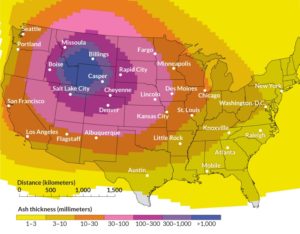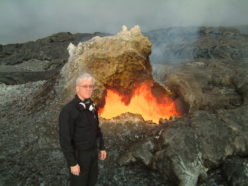If you’re being shot at, there is some satisfaction in knowing how often you’re being shot at. You can at least plan, and perhaps take some mitigating steps. To this end, the entire Pacific Northwest is preparing for the next magnitude 8+ subduction earthquake event by seismically retrofitting public buildings and holding “Great Shakeout” drills. This planning and preparation can be applied to volcanoes, even super volcanoes.
Q: Do geologists know when Yellowstone might erupt again? It appears to erupt at a Supervolcano level every few hundred thousand years.
The first was: 2,100,000 years ago
Second was: 1,200,000 years ago
And the last one was: 640,000 years ago
Are we in any danger of a fourth one?
– Brandon F
A: Yes is the short answer. Probably not in your lifetime is the long answer. There have been supervolcano eruptions moving with time along the Snake River Plain to modern Yellowstone starting at least 16.5 million years ago in southeastern Oregon.
Volcanologists in the USGS Volcano Science Center are very aware of this eruptive periodicity – we have a full-time volcanologist assigned to Yellowstone as the Scientist-in-Charge (SIC) of the Yellowstone Volcano Observatory. He works in close coordination with seismologists at the University of Utah, and with the US Park Service. Some links might be of interest to you:
https://volcanoes.usgs.gov/volcanoes/yellowstone/
https://volcanoes.usgs.gov/volcanoes/yellowstone/yellowstone_publications.html
There have been other, somewhat smaller eruptions at Yellowstone, however: The Scaup Lake rhyolite flow of 250,000 years ago, and a more recent hydrothermal blow-out about 70,000 years ago. Neither would have been trivial if you had been in the area, but they did not have the continental reach of the huge monsters you list.
You might want to check out the USGS Yellowstone hazard assessment:
Christiansen, R. L., Lowenstern, J. B., Smith, R. B., Heasler, H., Morgan, L. A., Nathenson, M., Mastin, L. G., Muffler, L. P. & Robinson, J. E. (2007). Preliminary Assessment of Volcanic and Hydrothermal Hazards in Yellowstone National Park and Vicinity. U.S. Geological Survey Open-File Report , 2007-1071, 98 p.
To make this a bit more real, there is a silvery-white ash deposit found all over most of the United States, sometimes called the Lava Creek Tuff (from a site locality in Kansas) or the Pearlette Ash Formation in older scientific literature. I have visited a single layer of this material near Colorado Springs, CO. There it is over 20 meters/70 feet thick; when it came down it may have been over 30 meters thick, but was consolidated with rainfall and the compressive weight of overlying material since then. This blanket of ash smothered all living things beneath it; I have personally pulled out a paleo-camel’s tooth from the bottom of the deposit. It ALL came from Yellowstone, over 800 kilometers/500 miles away!
Here’s what a future eruption might do (From Mastin, Van Eaton, and Lowenstern, 2014, “Modeling ash fall distribution from a Yellowstone supereruption”, Geochemistry, Geophysics, Geosystems, Vol 15, Issue 8, https://doi.org/10.1002/2014GC005469):
 |
| Figure 1. Likely distribution of ash and tephra from a future Yellowstone Caldera eruption (Mastin, Van Eaton, and Lowenstern, 2014). Fine details will depend on wind distribution and the volume of the erupted ash. |
Note that this is for a sophisticated 3D grid model that assumes prevailing westerly winds up to 16 – 24 km elevations. However, the model shows that the erupting plume would make its own prevailing winds, something that would allow an “umbrella cloud” to leave ash deposits throughout ALL conterminous US states, something consistent with geologic mapping of previous eruptions.
Another point is relevant here. Our experience is that, while you cannot predict an earthquake, you CAN predict a volcanic eruption if you have adequate instrumentation on the volcano. Several of our USGS staff returned recently from making their annual gravity and geodetic GPS survey (these surveys will detect any magmatic inflation). The caldera and surrounding terrane are very well-instrumented with telemetered seismometers, also.
The assessment of the Scientist-in-Charge when I last talked with him is that we are not likely to have a super-eruption in our lifetimes – that’s essentially what the 2007 assessment above says. I will excerpt key pieces of that assessment here:
“No volcanic eruption has occurred in Yellowstone National Park or vicinity in the last 70,000 years or more.”
“One statistical measure of eruption probabilities based on this episodic behavior suggests an average recurrence of 20,000years. The fact that no such eruption has occurred for more than 70,000 years may mean that insufficient eruptible magma remains beneath the Yellowstone caldera to produce another large-volume lava flow.”
Table 5. Estimates of annualized probability of events greater than a given magnitude.
Diameter (m) Area (m2) Events in last 14 thousand years Annualized Probability
>2 3.1 7000 (estimated) 0.50
>300 70,700 16 0.0013
>2000 3,140,000 2 0.00014”
This last table is from page 83 of the report. The chances for a large hydrothermal eruption next year (NOT a super volcano eruption) is just a bit over 1 in 10,000. For reasons explained above, the probabilities are likely even lower than this.
Bottom line: Those in the know are not currently worried about a Yellowstone “blow.”
A more recent paper (Lowenstern, Sisson, and Hurwitz, 2018, “Probing magma reservoirs to improve volcano forecasts”, EOS Vol. 99, No. 6, pp. 16-21) helps explain the uncertainties involved in making this assessment. Seismic tomography studies suggest that the Yellowstone magma reservoir is about 5%-15% melt, with all the rest being crystals that have slowly formed over the last several hundred thousand years. That’s still about 25 cubic kilometers of melt, larger than any volcano has spewed out on Earth since the eruption of Tambora (Indonesia) in 1815 caused the Year Without Summer in Europe, with snow in June and mass starvation following crop failures.
The current understanding in the volcanology community is that a magma reservoir is not eruptible with less than 50% melt… however, this assumes a homogeneous distribution of crystals and melt fraction. Looking closely at the steep compositional gradients in crystals erupted 250,000 years ago at Yellowstone, calculations suggest that the crystalline mush had lain dormant for ~220,000 years – but then was remobilized in as little as a mere 10 months.
The main concern is that if there is another injection of hot basalt from the mantle into the base of this reservoir, it could remobilize the reservoir and become eruptible in less than a year.
In the meantime, the volcano is very closely monitored 24/7. Please understand that there are a number of scientists within and outside of the US Geological Survey who are monitoring Yellowstone, literally, on an hourly basis. They think about your question every day.
~~~~~
